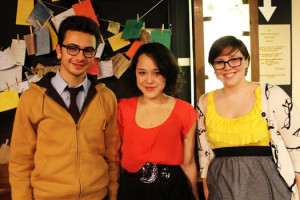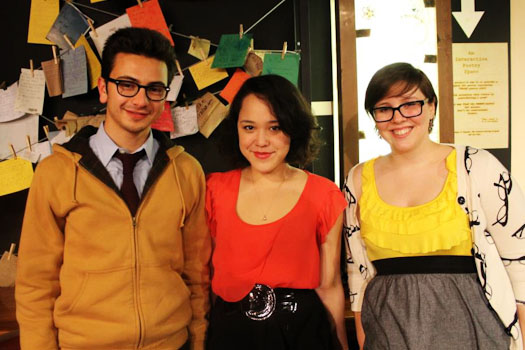“He didn’t care that despite the vast amount of evidence he compiled, people could not let go of their fixed world view. He kept going. He was, in a word, resilient.”
A calm, cool voice floats over the air, highly reminiscent of one car drivers might tune in to while trapped in an early morning traffic jam. In this case it is the voice of Jonah Willihnganz, director of the Stanford Storytelling Project, as he opens the project’s latest episode on Stanford’s radio station, KZSU. He uses the example of geologist Alfred Wegner, who doggedly defended the concept of continental drift to a skeptical audience in the early 1900s, to introduce the week’s topic: resilience.
Five different stories, written and read by Stanford students and affiliates, all dealing with the topic of resilience, follow this introduction. The stories are dramatically varied, accounts ranging from the resilience required to work for the Stanford Calling Center to the resilience one individual called upon while attending Burning Man, an arts event in the Nevada desert.
“[A theme] can mean anything,” said Dana Kletter, Stegner fellow and fiction editor of the Storytelling Project. “People start making these associations…Have they heard a story that might fit into this category, or might fit in with this theme?”

The radio component of the project experiments with the ability of a “disembodied” voice to convey a story, and according to Willihnganz, parallels the alienated nature of the modern state of life.
“In the early 20th century the voices were able to become completely disconnected,” Willihnganz said. “You could hear somebody’s consciousness, richly, without their being present…The physical reality could become divorced from an essence.”
Aside from these existentially challenging traits, the medium of radio also provides listeners with an auditory experience that is less detached than writing and less passive than television.
“I really like audio because I feel like it impacts us more emotionally than writing would, because it’s auditory and we respond to the sound of other humans speaking, but it still leaves room for the imagination,” said Hannah Kopp-Yates ’12, a contributor to the Storytelling Project.
Though the KZSU show is perhaps the most well-known component of the Stanford Storytelling Project, it is only one segment. Founded in 2007, the Stanford Storytelling Project was created by Willinhganz, who was a fellow with the Stanford Humanities Fund at the time. Realizing the public impact of programs such as NPR’s “This American Life,” Willihnganz received funding through the Hume Writing Center and the Continuing Studies Program and began to teach classes. In these classes, students focused on writing their own memoirs and on collecting stories from around campus. Soon however, the “story collecting” expanded beyond the courses.
In essence, the Storytelling Project strives to teach people to be effective storytellers while simultaneously capturing the many stories present in the Stanford community.
“It’s really a lot like ethnography, which I’m really interested in, and what we’re all really interested in,” Kletter said. “That’s how we investigate other cultures, using these kind of ethnographic methods and field notes, so why not examine ourselves that way?”
Much of the Storytelling Project involves collaboration with other University programs. On Friday afternoons, members of the Storytelling Project join with oral communication tutors from the Oral Communication Center for a storytelling workshop. The members serve as mentors to students who have a story to tell, helping them with performance and rhetorical techniques.
“[The Storytelling Project’s] purpose was not only to allow students to create these things, to help push them through the process, but to also bring the campus more storytelling,” Willihnganz said.
Additionally, the Storytelling Project has been working on implementing a program called “Big Shorts” at the CoHo, which brings in famous storytellers of all kinds on Tuesday nights, from radio show hosts to poets. There has also been a recent upsurge in collaboration with the Stanford Medical School, particularly because of the on-campus presence of writer-doctor Abraham Verghese. Verghese came to Stanford as a tenured professor in 2007 and currently holds the position of Professor for the Theory and Practice of Medicine at the Stanford Universtiy School of Medicine and Senior Associate Chair of the Department of Internal Medicine.
“There’s actually a lot of writers who were doctors,” Kletter said. “Maybe it’s the fact that they interact with patients, maybe because you take a patient’s history, and there’s a bi-narrative there. Behind the numbers there is always a human story.”
Students can get involved with the Storytelling Project as staff members or as collaborators, a position that pays $100 for each story contributed. Kopp-Yates first became involved with the Storytelling Project while studying abroad in Paris. Responding affirmatively to an email asking students to record their adventures abroad, she received a microphone in the mail and was charged with the task of finding interesting personal narratives in the City of Lights. Stories she found included that of two Stanford girls wooed by three French men at the Eiffel Tower on New Year’s Eve and that of a non-French-speaker traveling to southern France to learn a traditional French game.
As a human biology major focusing on human-environmental interactions, Kopp-Yates said she believes narratives have great potential to enact social change.
“I think that narrative is really important in creating global transformation,” Kopp-Yates said. “One of the reasons that there’s so much alienation and disenfranchisement and disconnection from the natural world is because at least in America we don’t really know how to place ourselves in it anymore.”
